DODGE GRAND CARAVAN 2008 5.G Owners Manual
Manufacturer: DODGE, Model Year: 2008, Model line: GRAND CARAVAN, Model: DODGE GRAND CARAVAN 2008 5.GPages: 531, PDF Size: 7.72 MB
Page 321 of 531
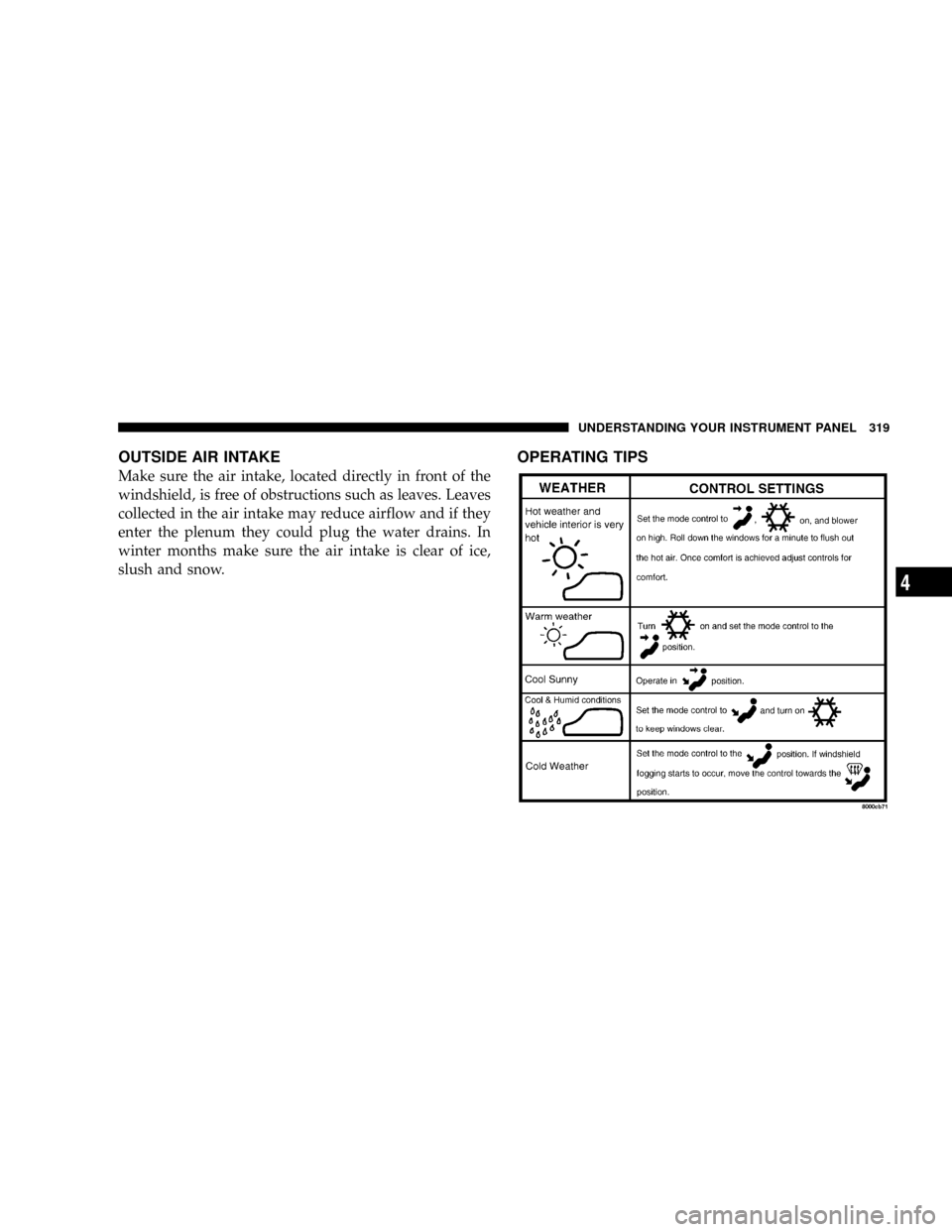
OUTSIDE AIR INTAKE
Make sure the air intake, located directly in front of the
windshield, is free of obstructions such as leaves. Leaves
collected in the air intake may reduce airflow and if they
enter the plenum they could plug the water drains. In
winter months make sure the air intake is clear of ice,
slush and snow.
OPERATING TIPS
UNDERSTANDING YOUR INSTRUMENT PANEL 319
4
Page 322 of 531
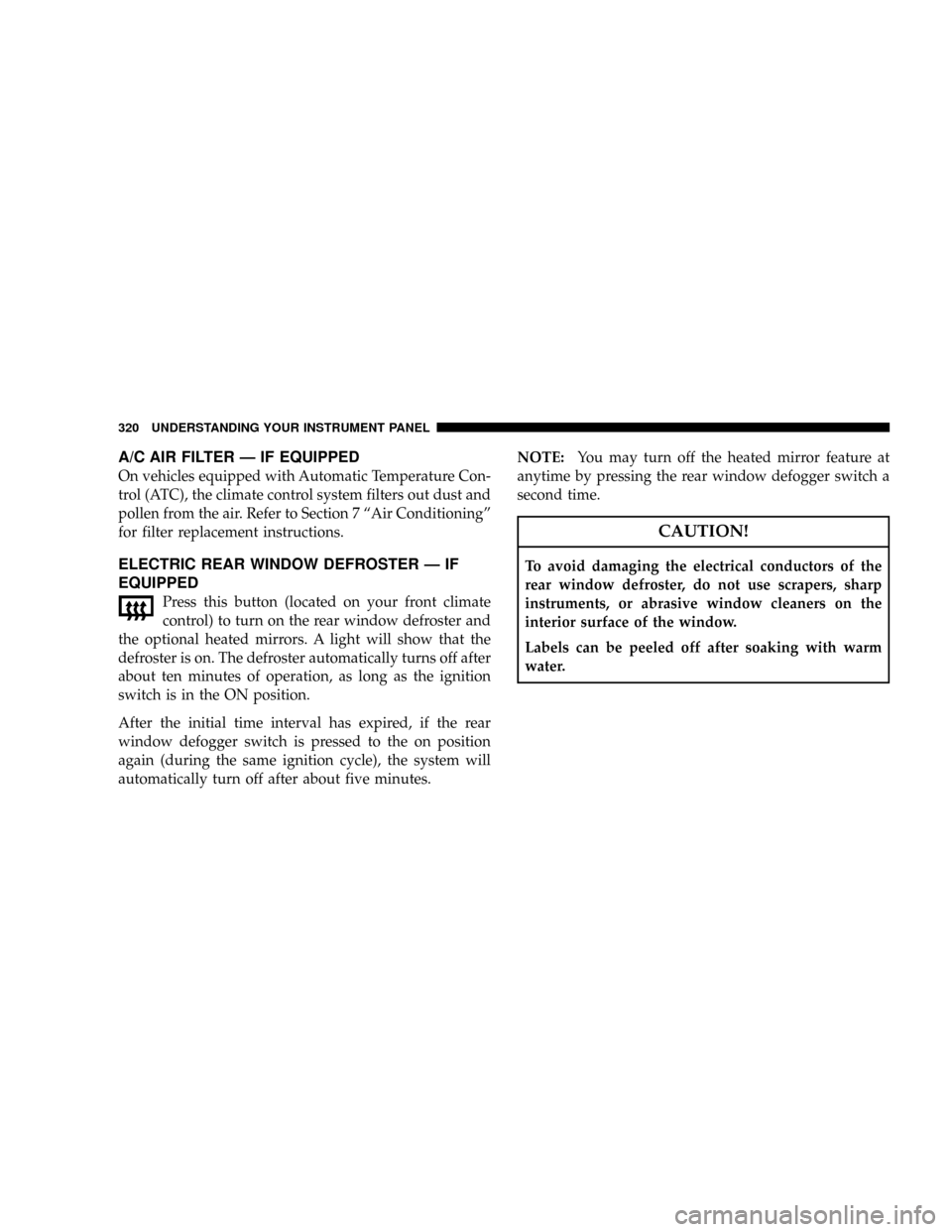
A/C AIR FILTER Ð IF EQUIPPED
On vehicles equipped with Automatic Temperature Con-
trol (ATC), the climate control system filters out dust and
pollen from the air. Refer to Section 7 ªAir Conditioningº
for filter replacement instructions.
ELECTRIC REAR WINDOW DEFROSTER Ð IF
EQUIPPED
Press this button (located on your front climate
control) to turn on the rear window defroster and
the optional heated mirrors. A light will show that the
defroster is on. The defroster automatically turns off after
about ten minutes of operation, as long as the ignition
switch is in the ON position.
After the initial time interval has expired, if the rear
window defogger switch is pressed to the on position
again (during the same ignition cycle), the system will
automatically turn off after about five minutes.NOTE:You may turn off the heated mirror feature at
anytime by pressing the rear window defogger switch a
second time.
CAUTION!
To avoid damaging the electrical conductors of the
rear window defroster, do not use scrapers, sharp
instruments, or abrasive window cleaners on the
interior surface of the window.
Labels can be peeled off after soaking with warm
water.
320 UNDERSTANDING YOUR INSTRUMENT PANEL
Page 323 of 531
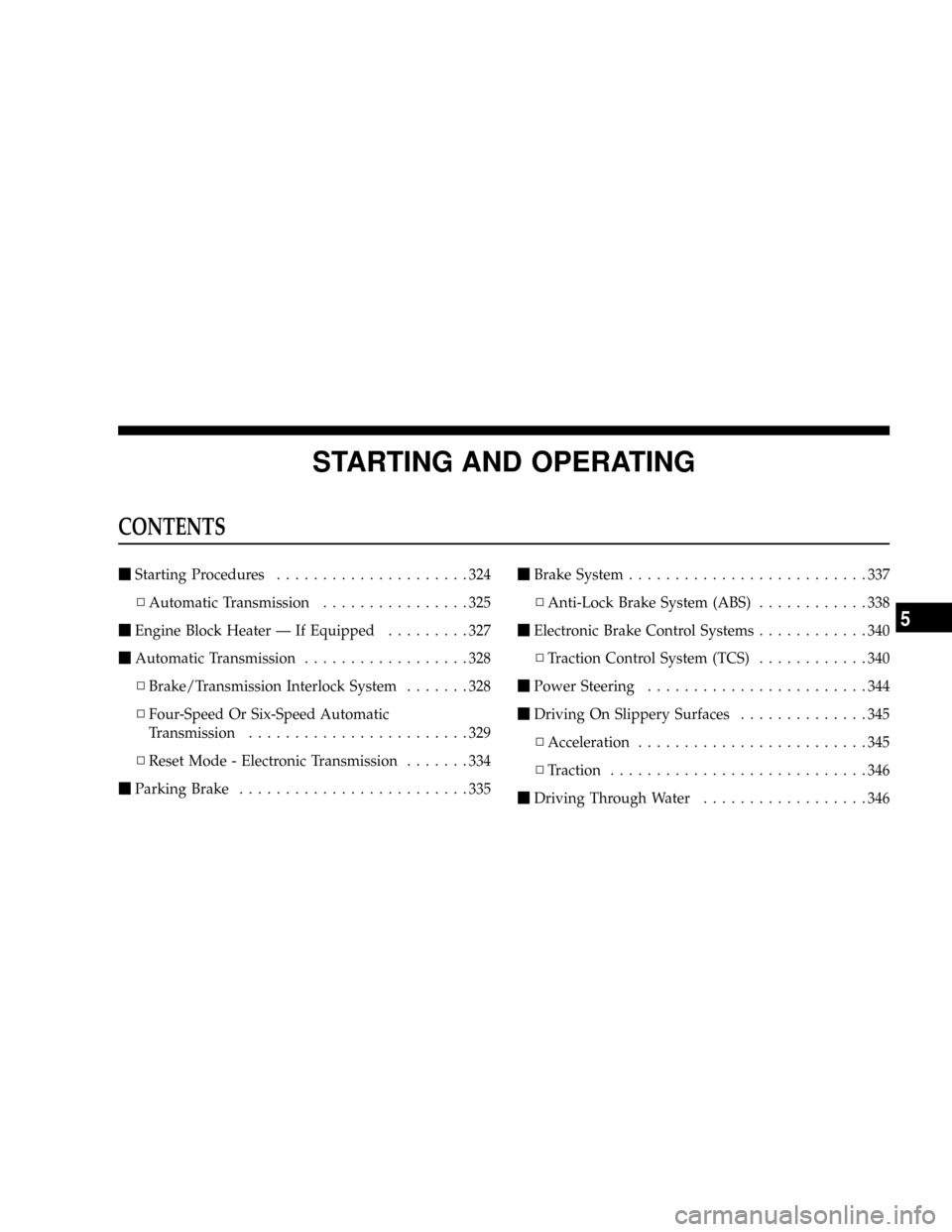
STARTING AND OPERATING
CONTENTS
mStarting Procedures.....................324
NAutomatic Transmission................325
mEngine Block Heater Ð If Equipped.........327
mAutomatic Transmission..................328
NBrake/Transmission Interlock System.......328
NFour-Speed Or Six-Speed Automatic
Transmission........................329
NReset Mode - Electronic Transmission.......334
mParking Brake.........................335mBrake System..........................337
NAnti-Lock Brake System (ABS)............338
mElectronic Brake Control Systems............340
NTraction Control System (TCS)............340
mPower Steering........................344
mDriving On Slippery Surfaces..............345
NAcceleration.........................345
NTraction............................346
mDriving Through Water..................346
5
Page 324 of 531
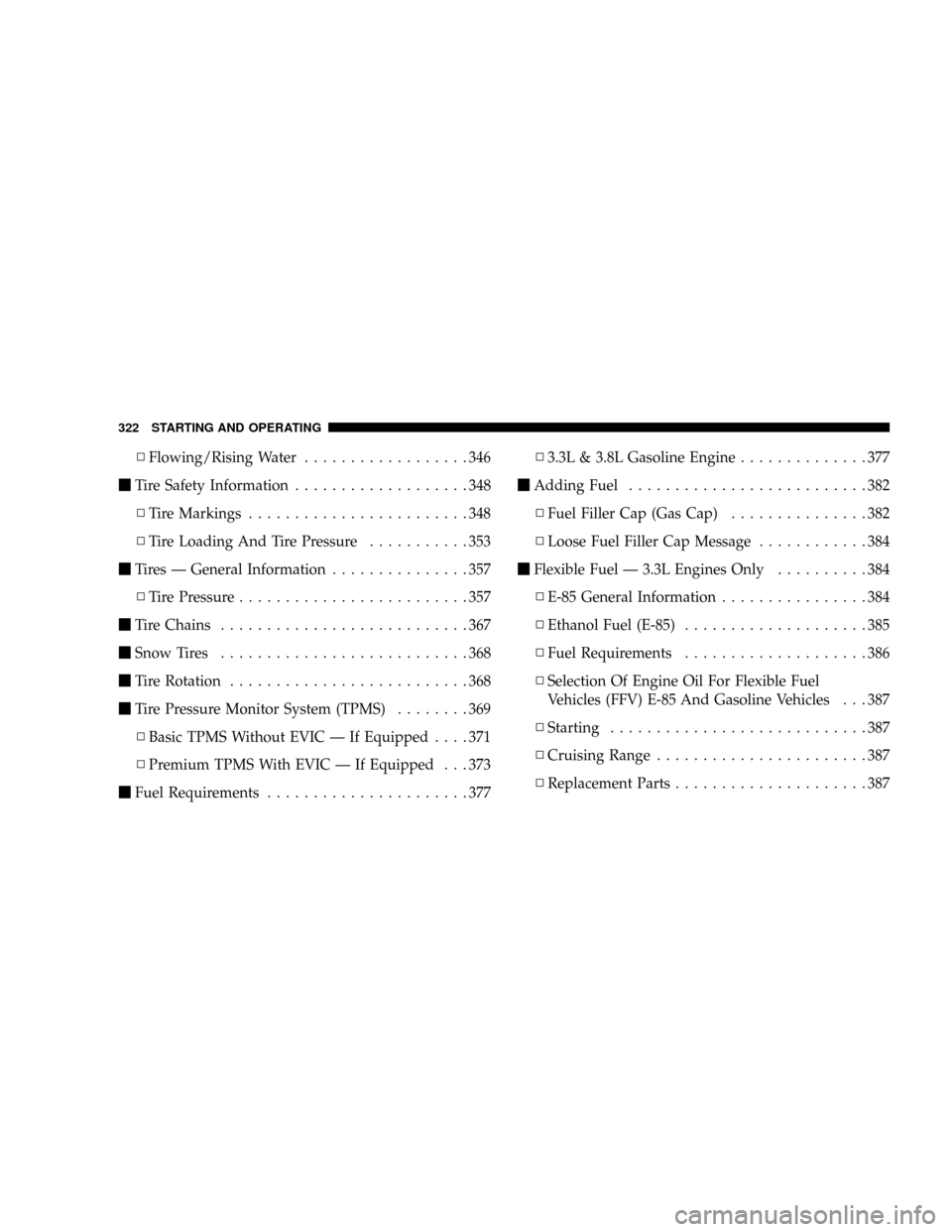
NFlowing/Rising Water..................346
mTire Safety Information...................348
NTire Markings........................348
NTire Loading And Tire Pressure...........353
mTires Ð General Information...............357
NTire Pressure.........................357
mTire Chains...........................367
mSnow Tires...........................368
mTire Rotation..........................368
mTire Pressure Monitor System (TPMS)........369
NBasic TPMS Without EVIC Ð If Equipped....371
NPremium TPMS With EVIC Ð If Equipped . . . 373
mFuel Requirements......................377N3.3L & 3.8L Gasoline Engine..............377
mAdding Fuel..........................382
NFuel Filler Cap (Gas Cap)...............382
NLoose Fuel Filler Cap Message............384
mFlexible Fuel Ð 3.3L Engines Only..........384
NE-85 General Information................384
NEthanol Fuel (E-85)....................385
NFuel Requirements....................386
NSelection Of Engine Oil For Flexible Fuel
Vehicles (FFV) E-85 And Gasoline Vehicles . . . 387
NStarting............................387
NCruising Range.......................387
NReplacement Parts.....................387
322 STARTING AND OPERATING
Page 325 of 531
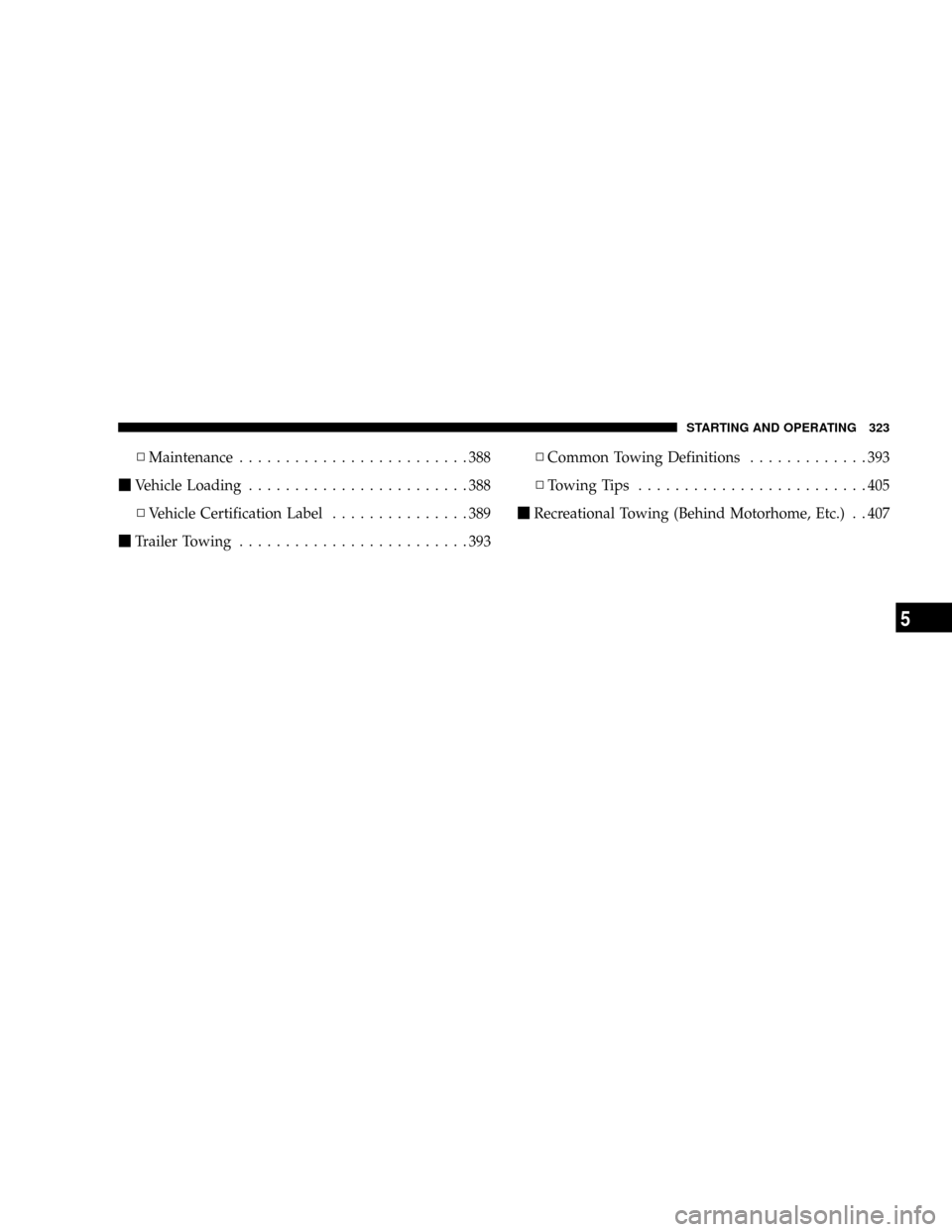
NMaintenance.........................388
mVehicle Loading........................388
NVehicle Certification Label...............389
mTrailer Towing.........................393NCommon Towing Definitions.............393
NTowing Tips.........................405
mRecreational Towing (Behind Motorhome, Etc.) . . 407
STARTING AND OPERATING 323
5
Page 326 of 531
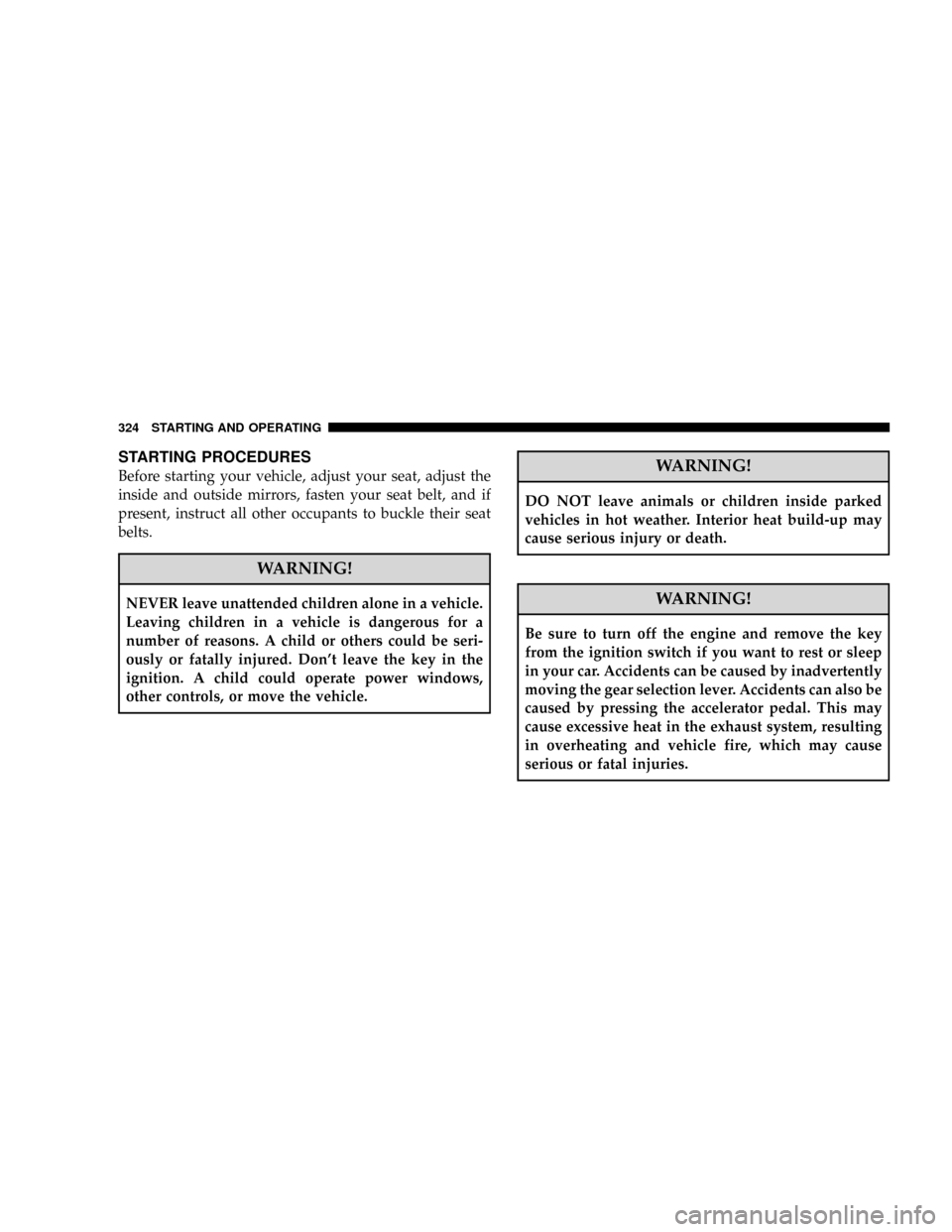
STARTING PROCEDURES
Before starting your vehicle, adjust your seat, adjust the
inside and outside mirrors, fasten your seat belt, and if
present, instruct all other occupants to buckle their seat
belts.
WARNING!
NEVER leave unattended children alone in a vehicle.
Leaving children in a vehicle is dangerous for a
number of reasons. A child or others could be seri-
ously or fatally injured. Don't leave the key in the
ignition. A child could operate power windows,
other controls, or move the vehicle.
WARNING!
DO NOT leave animals or children inside parked
vehicles in hot weather. Interior heat build-up may
cause serious injury or death.
WARNING!
Be sure to turn off the engine and remove the key
from the ignition switch if you want to rest or sleep
in your car. Accidents can be caused by inadvertently
moving the gear selection lever. Accidents can also be
caused by pressing the accelerator pedal. This may
cause excessive heat in the exhaust system, resulting
in overheating and vehicle fire, which may cause
serious or fatal injuries.
324 STARTING AND OPERATING
Page 327 of 531
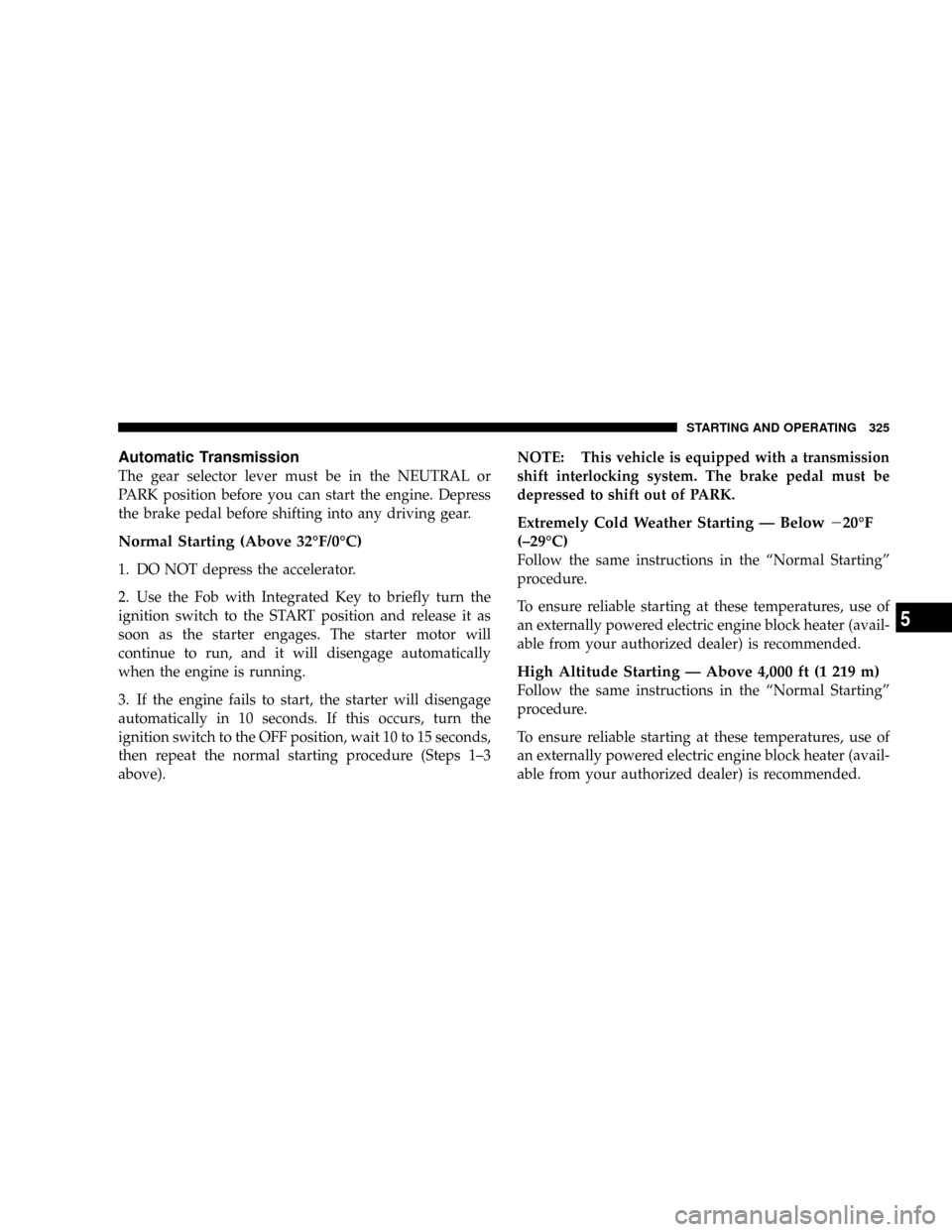
Automatic Transmission
The gear selector lever must be in the NEUTRAL or
PARK position before you can start the engine. Depress
the brake pedal before shifting into any driving gear.
Normal Starting (Above 32ÉF/0ÉC)
1. DO NOT depress the accelerator.
2. Use the Fob with Integrated Key to briefly turn the
ignition switch to the START position and release it as
soon as the starter engages. The starter motor will
continue to run, and it will disengage automatically
when the engine is running.
3. If the engine fails to start, the starter will disengage
automatically in 10 seconds. If this occurs, turn the
ignition switch to the OFF position, wait 10 to 15 seconds,
then repeat the normal starting procedure (Steps 1±3
above).NOTE: This vehicle is equipped with a transmission
shift interlocking system. The brake pedal must be
depressed to shift out of PARK.
Extremely Cold Weather Starting Ð Below220ÉF
(±29ÉC)
Follow the same instructions in the ªNormal Startingº
procedure.
To ensure reliable starting at these temperatures, use of
an externally powered electric engine block heater (avail-
able from your authorized dealer) is recommended.
High Altitude Starting Ð Above 4,000 ft (1 219 m)
Follow the same instructions in the ªNormal Startingº
procedure.
To ensure reliable starting at these temperatures, use of
an externally powered electric engine block heater (avail-
able from your authorized dealer) is recommended.
STARTING AND OPERATING 325
5
Page 328 of 531
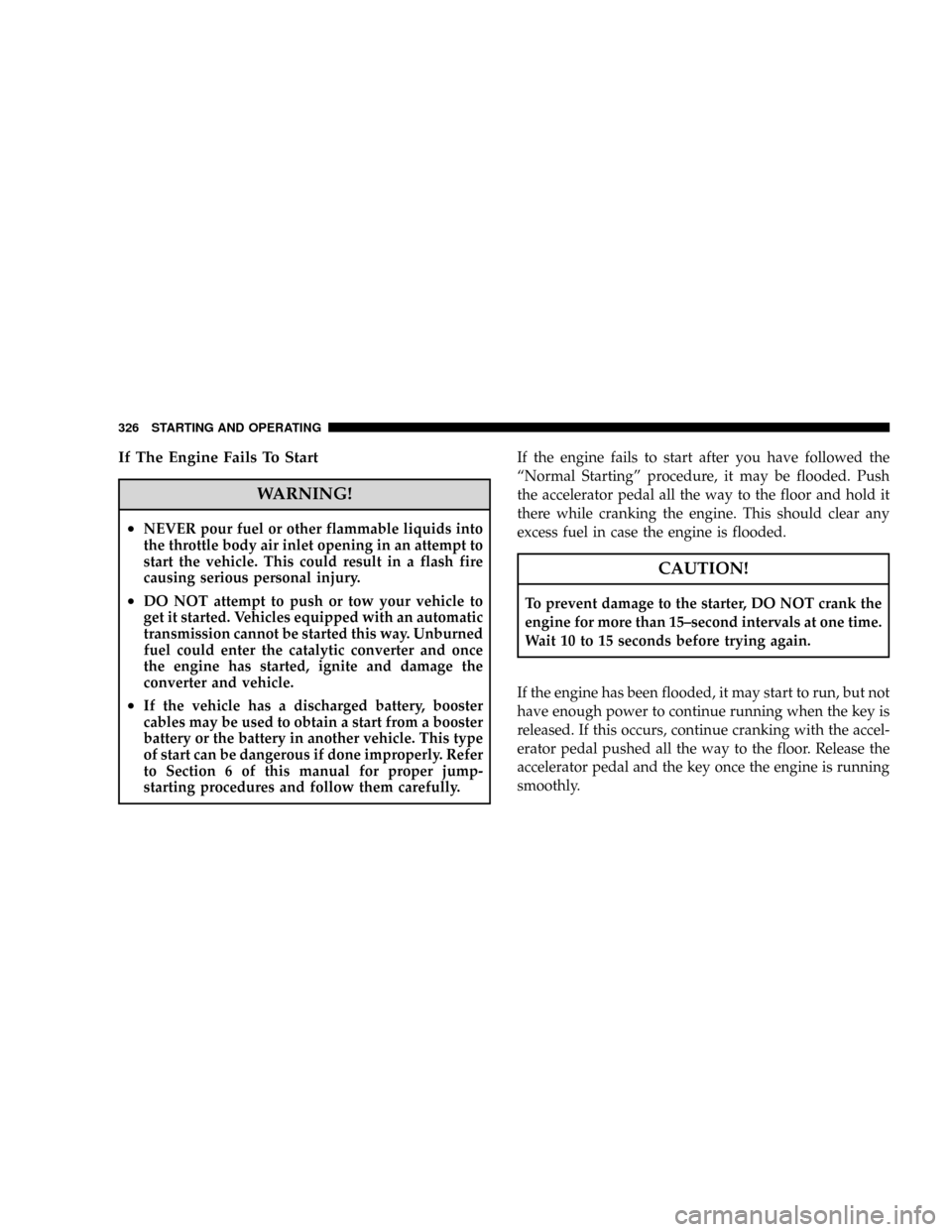
If The Engine Fails To Start
WARNING!
²NEVER pour fuel or other flammable liquids into
the throttle body air inlet opening in an attempt to
start the vehicle. This could result in a flash fire
causing serious personal injury.
²DO NOT attempt to push or tow your vehicle to
get it started. Vehicles equipped with an automatic
transmission cannot be started this way. Unburned
fuel could enter the catalytic converter and once
the engine has started, ignite and damage the
converter and vehicle.
²If the vehicle has a discharged battery, booster
cables may be used to obtain a start from a booster
battery or the battery in another vehicle. This type
of start can be dangerous if done improperly. Refer
to Section 6 of this manual for proper jump-
starting procedures and follow them carefully.If the engine fails to start after you have followed the
ªNormal Startingº procedure, it may be flooded. Push
the accelerator pedal all the way to the floor and hold it
there while cranking the engine. This should clear any
excess fuel in case the engine is flooded.
CAUTION!
To prevent damage to the starter, DO NOT crank the
engine for more than 15±second intervals at one time.
Wait 10 to 15 seconds before trying again.
If the engine has been flooded, it may start to run, but not
have enough power to continue running when the key is
released. If this occurs, continue cranking with the accel-
erator pedal pushed all the way to the floor. Release the
accelerator pedal and the key once the engine is running
smoothly.
326 STARTING AND OPERATING
Page 329 of 531
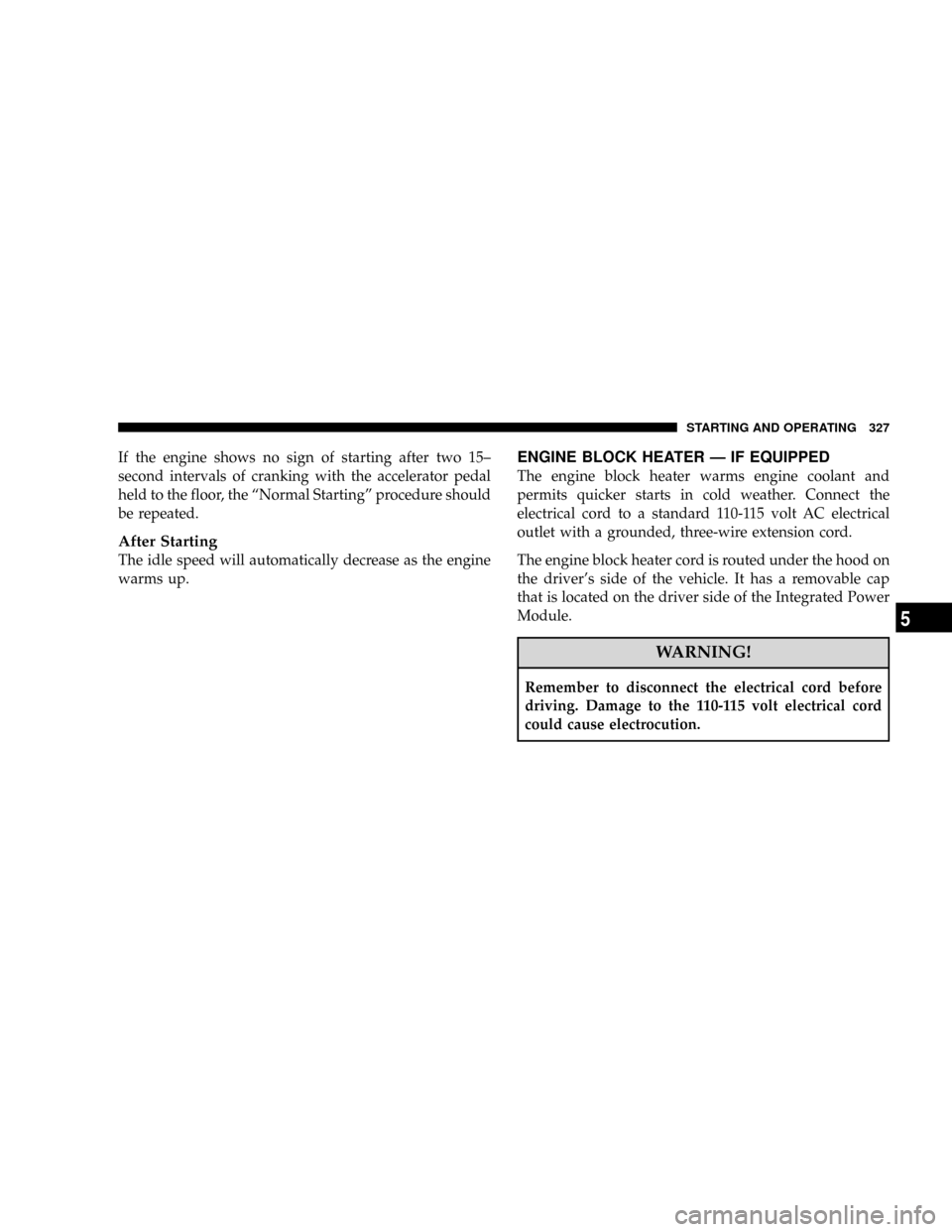
If the engine shows no sign of starting after two 15±
second intervals of cranking with the accelerator pedal
held to the floor, the ªNormal Startingº procedure should
be repeated.
After Starting
The idle speed will automatically decrease as the engine
warms up.
ENGINE BLOCK HEATER Ð IF EQUIPPED
The engine block heater warms engine coolant and
permits quicker starts in cold weather. Connect the
electrical cord to a standard 110-115 volt AC electrical
outlet with a grounded, three-wire extension cord.
The engine block heater cord is routed under the hood on
the driver's side of the vehicle. It has a removable cap
that is located on the driver side of the Integrated Power
Module.
WARNING!
Remember to disconnect the electrical cord before
driving. Damage to the 110-115 volt electrical cord
could cause electrocution.
STARTING AND OPERATING 327
5
Page 330 of 531
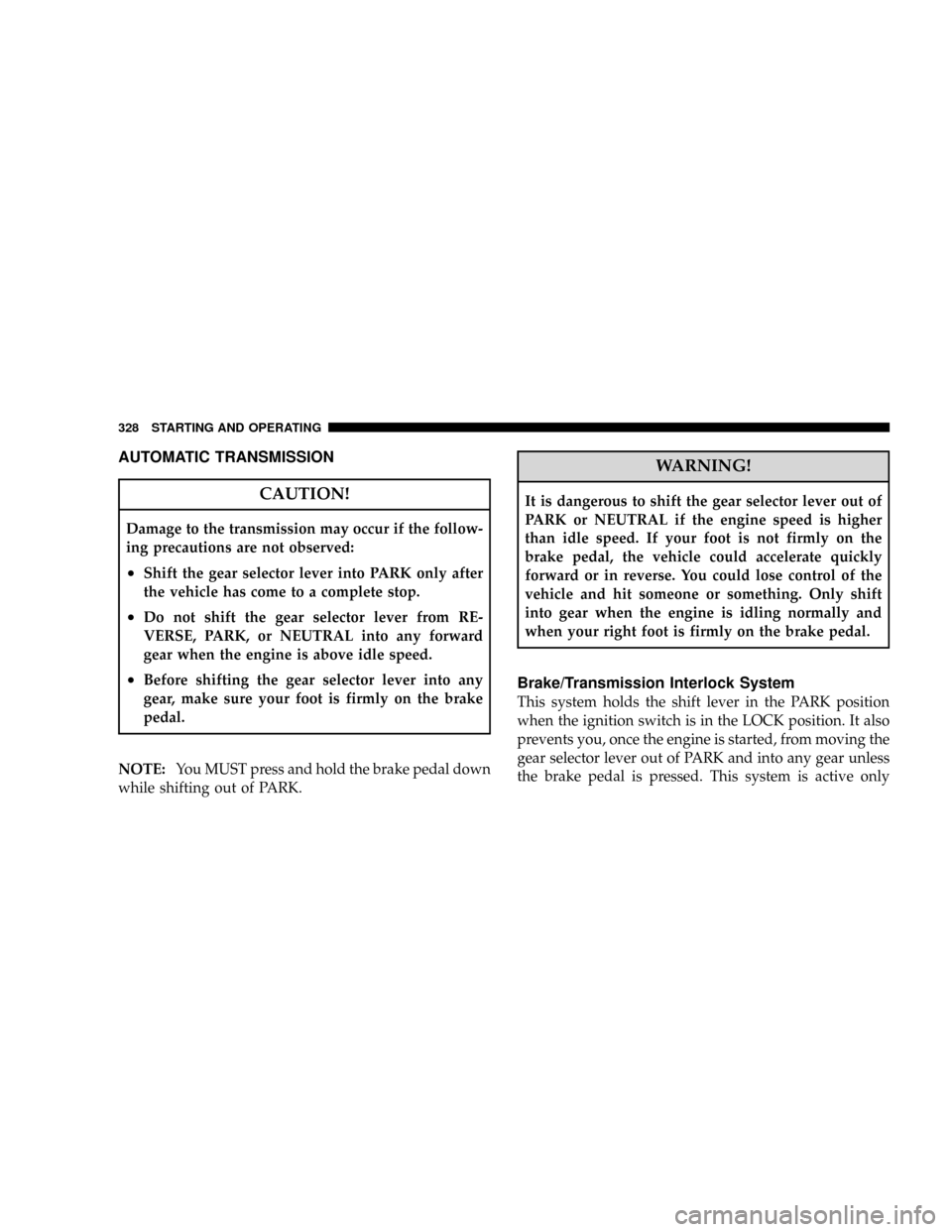
AUTOMATIC TRANSMISSION
CAUTION!
Damage to the transmission may occur if the follow-
ing precautions are not observed:
²Shift the gear selector lever into PARK only after
the vehicle has come to a complete stop.
²Do not shift the gear selector lever from RE-
VERSE, PARK, or NEUTRAL into any forward
gear when the engine is above idle speed.
²Before shifting the gear selector lever into any
gear, make sure your foot is firmly on the brake
pedal.
NOTE:You MUST press and hold the brake pedal down
while shifting out of PARK.
WARNING!
It is dangerous to shift the gear selector lever out of
PARK or NEUTRAL if the engine speed is higher
than idle speed. If your foot is not firmly on the
brake pedal, the vehicle could accelerate quickly
forward or in reverse. You could lose control of the
vehicle and hit someone or something. Only shift
into gear when the engine is idling normally and
when your right foot is firmly on the brake pedal.
Brake/Transmission Interlock System
This system holds the shift lever in the PARK position
when the ignition switch is in the LOCK position. It also
prevents you, once the engine is started, from moving the
gear selector lever out of PARK and into any gear unless
the brake pedal is pressed. This system is active only
328 STARTING AND OPERATING